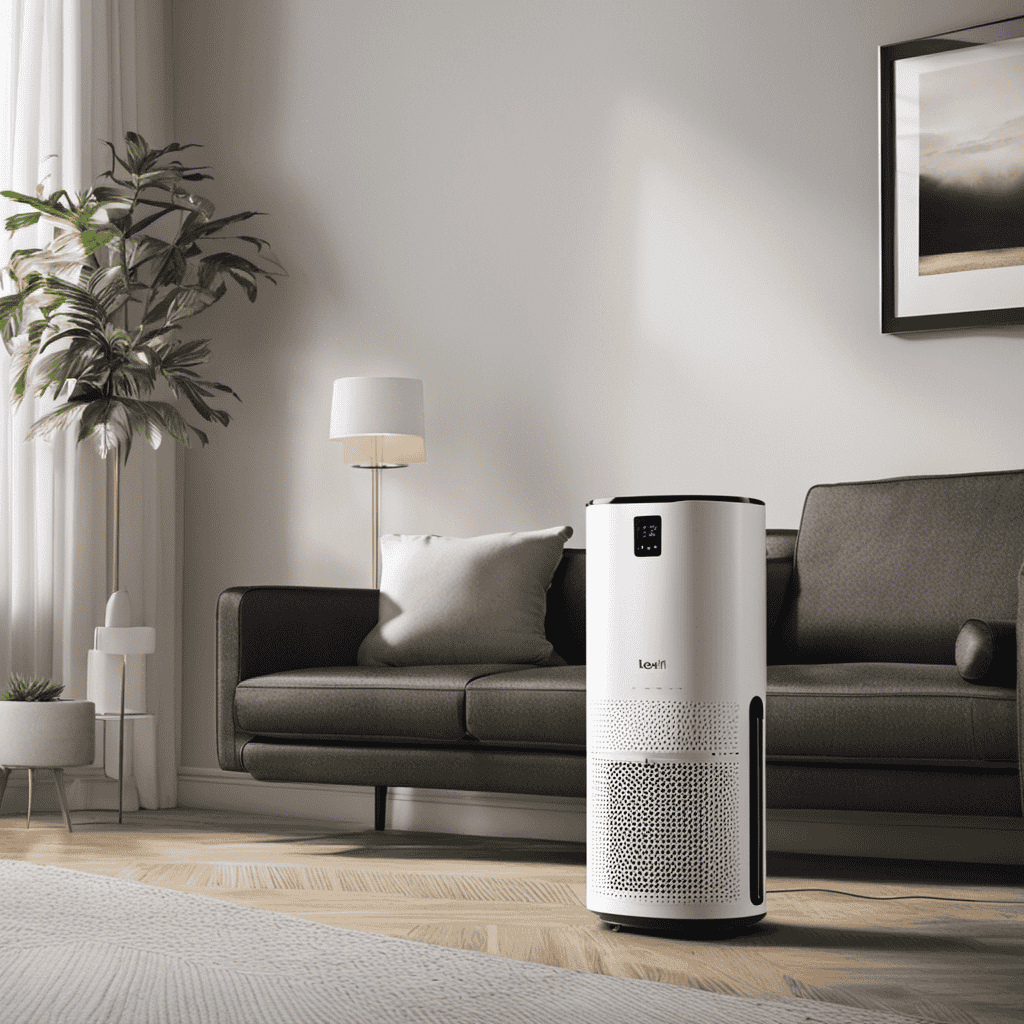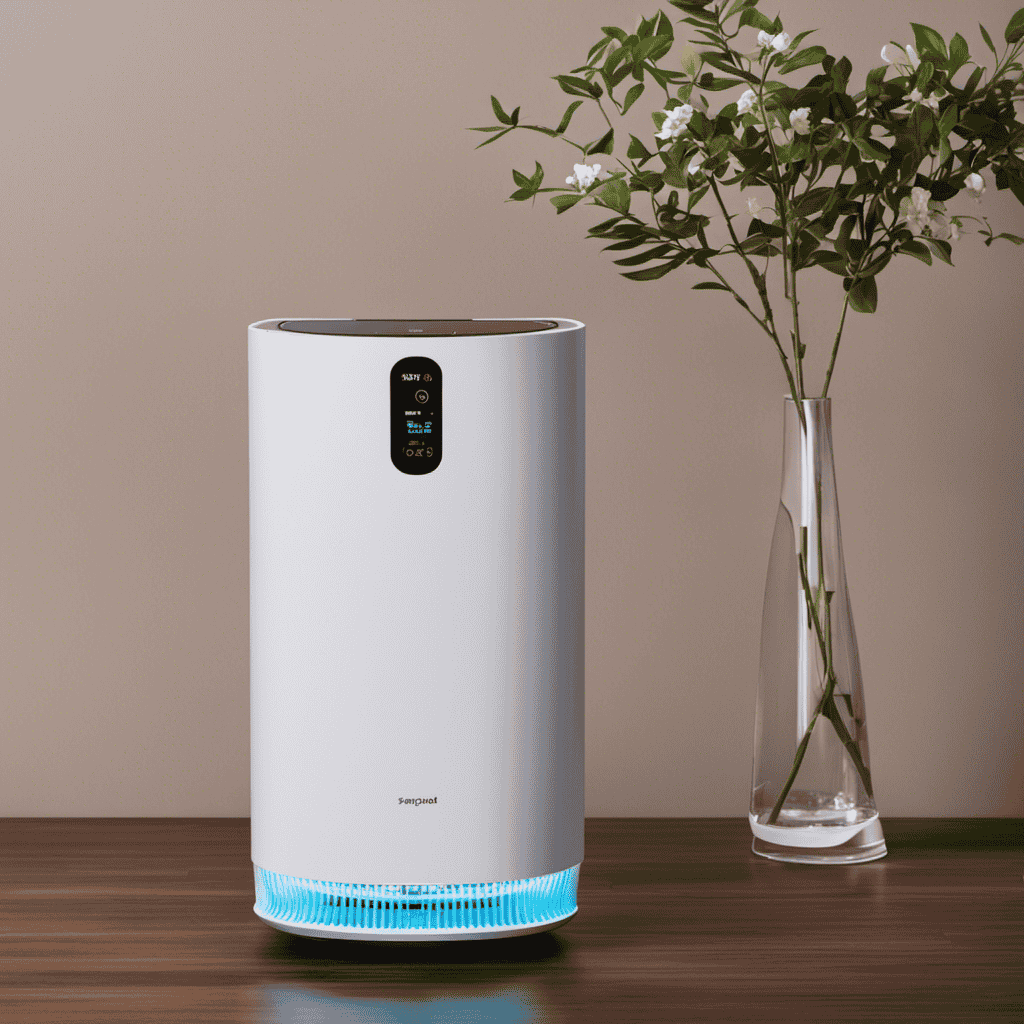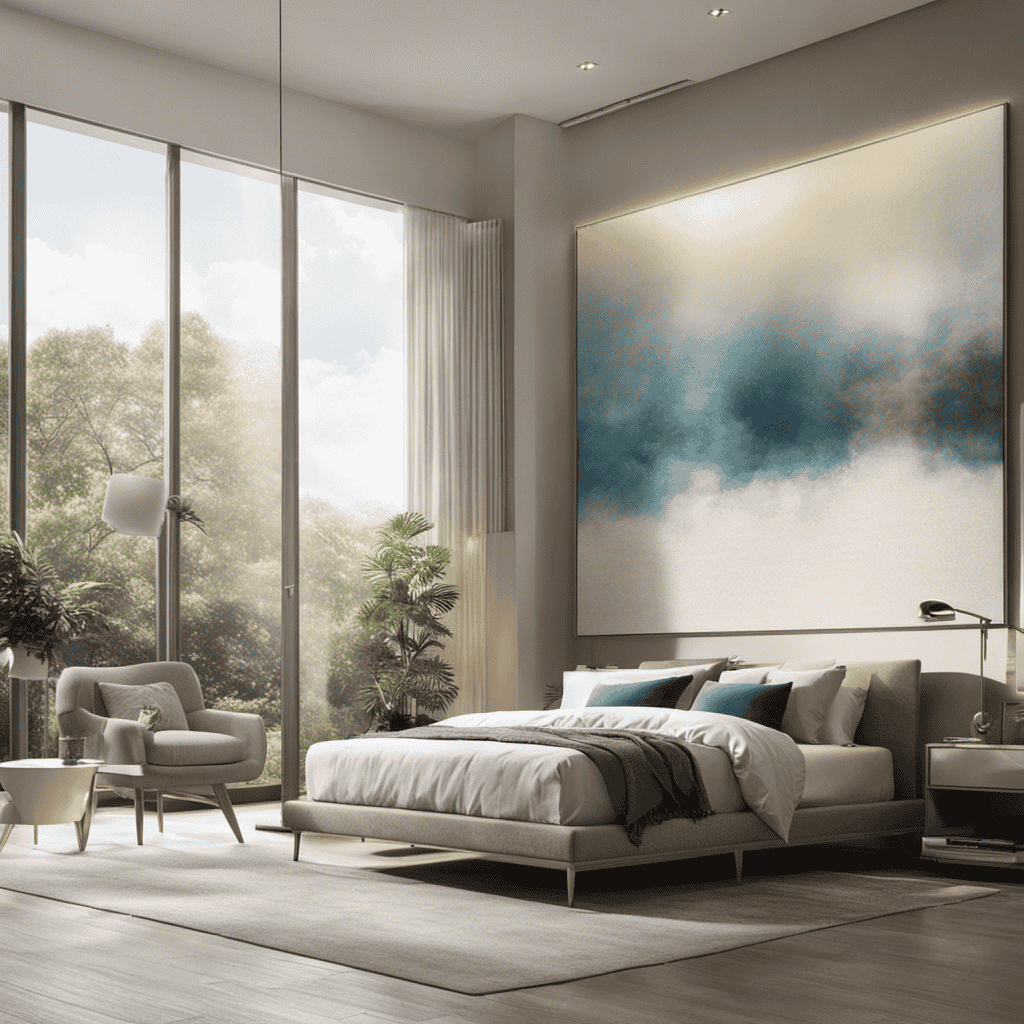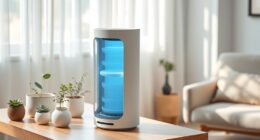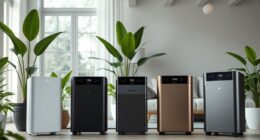You may have observed the red light on your Levoit air purifier and are curious about how to disable it. Don’t worry, you’re in the right spot. This article will walk you through the process of turning off the bothersome red light indicator.
We’ll dive into understanding the causes behind it, checking the air quality sensor, and even troubleshooting advanced red light problems.
By the end, you’ll have a clear understanding of how to optimize the performance of your Levoit air purifier and keep that red light at bay.
Let’s get started!
Key Takeaways
- The red light on a Levoit air purifier indicates that the filter needs to be replaced or cleaned.
- Regularly clean the pre-filter and air inlet grille to prevent dust build-up.
- Troubleshoot the red light issue by checking and cleaning the filter.
- Reset the air purifier by holding down the power button to see if the red light turns off.
Understanding the Red Light Indicator on Your Levoit Air Purifier
If you’re wondering what the red light on your Levoit air purifier means, I’m here to help.
There are some common misconceptions about the red light indicator, so let’s clear them up. The red light typically indicates that the filter needs to be replaced or cleaned. It’s important to note that the red light is not a malfunction indicator.
To reduce the frequency of the red light, follow these tips:
Firstly, make sure to regularly clean the pre-filter and the air inlet grille to prevent dust build-up.
Secondly, avoid using the air purifier in areas with high levels of smoke or pollutants, as this can clog the filter faster.
Lastly, consider upgrading to a higher quality filter, such as the Levoit LV-H133 True HEPA filter, which has a longer lifespan.
Identifying the Causes of the Red Light on Your Levoit Air Purifier
When it comes to the red light on your Levoit Air Purifier, there are a few common triggers that may be causing it. Understanding these triggers is crucial in troubleshooting the issue effectively.
In this discussion, I will delve into the common red light triggers and provide you with troubleshooting tips to resolve the problem.
Common Red Light Triggers
To turn off the red light on your Levoit air purifier, check if the filter needs to be replaced or cleaned. Many people have misconceptions about the red light indicator on their Levoit air purifier. Here are three common triggers that can cause the red light to come on:
-
Dirty or Clogged Filter: If the filter is dirty or clogged with dust and debris, it can trigger the red light. To resolve this, remove the filter and clean it according to the manufacturer’s instructions.
-
Filter Replacement Needed: Over time, the filter in your Levoit air purifier may need to be replaced. If the filter is old and no longer effective, it can cause the red light to illuminate. Replace the filter with a new one to resolve this issue.
-
Sensor Malfunction: In some cases, the red light may indicate a sensor malfunction. If you’ve checked the filter and it is clean or has been replaced, contact Levoit customer support for further assistance.
Troubleshooting the Issue
One possible solution for troubleshooting the issue is to clean or replace the filter in your Levoit air purifier. Regular air purifier maintenance is crucial to ensure optimal performance and to prevent the red light from turning on.
Over time, the filter can become clogged with dust, allergens, and other particles, reducing its efficiency and triggering the red light indicator. To clean the filter, gently remove it from the air purifier and use a soft brush or vacuum cleaner to remove any accumulated debris.
If the filter is damaged or too dirty to be cleaned, it is recommended to replace it with a new one. Proper filter maintenance will not only help resolve the red light issue but also improve the overall air quality in your home.
Now, let’s move on to a step-by-step guide to turning off the red light on your Levoit air purifier.
Step-By-Step Guide to Turning off the Red Light on Your Levoit Air Purifier
In this discussion, I will guide you through the process of troubleshooting the red light on your Levoit Air Purifier and understanding common error indicators.
When the red light appears on your air purifier, it indicates that there is an issue that needs to be addressed. By following the troubleshooting steps, you can identify and resolve the problem causing the red light.
Additionally, I will explain how to reset the air purifier, which can often resolve minor issues and restore the device to its normal functioning.
Lastly, I will provide an overview of common error indicators that you may encounter, helping you to quickly identify and resolve any issues that arise with your Levoit Air Purifier.
Red Light Troubleshooting
First, check if the red light on your Levoit air purifier is indicating a filter replacement issue. If the red light is on, it means that the filter needs to be replaced.
Here are three steps to troubleshoot the red light maintenance issue:
-
Check the filter: Open the air purifier and inspect the filter. If it is dirty or clogged, it needs to be replaced. Refer to the user manual for instructions on how to properly replace the filter.
-
Clean the air intake: Sometimes, the red light may be triggered by a clogged air intake. Use a soft cloth or brush to gently clean the intake vents and remove any dust or debris.
-
Reset the air purifier: If the red light persists after replacing the filter and cleaning the intake, try resetting the air purifier. This can typically be done by pressing and holding the power button for a few seconds.
To further troubleshoot the red light issue, let’s move on to the next section about resetting the air purifier.
Resetting the Air Purifier
If the red light persists, try resetting the air purifier by holding down the power button for a few seconds. Resetting the air purifier can help resolve issues with the filter or the sensor.
To reset the filter, turn off the air purifier and remove the filter from its compartment. Gently tap the filter to remove any accumulated dust or debris. Then, reinsert the filter back into the air purifier and turn it on. This should reset the filter and clear any clogs or blockages that may be causing the red light to stay on.
If the red light is indicating a problem with the sensor, resetting the air purifier can recalibrate the sensor and resolve any inaccuracies. Once the air purifier is reset, monitor the red light to see if it turns off.
If the red light remains on, it may indicate a different issue that requires further troubleshooting.
Now, let’s move on to the next section and explore common error indicators you may encounter with your Levoit air purifier.
Common Error Indicators
Resetting the air purifier can often resolve common error indicators that may occur with your Levoit air purifier. Here are three common causes and solutions for these error indicators:
-
Filter Replacement Needed: One common error indicator is a flashing light indicating that the filter needs to be replaced. This can be caused by a dirty or clogged filter. The solution is to replace the filter with a new one according to the manufacturer’s instructions.
-
Sensor Malfunction: Another common error indicator is a constant red light, indicating a sensor malfunction. This can be caused by a faulty sensor or a build-up of dust or debris on the sensor. The solution is to clean the sensor using a soft cloth or brush, or to contact Levoit customer support for further assistance.
-
Power Interruption: Sometimes, a power interruption can cause error indicators to appear. The solution is to unplug the air purifier, wait for a few minutes, and then plug it back in to reset it.
By addressing these common causes and solutions, you can troubleshoot and resolve error indicators on your Levoit air purifier.
Now, let’s move on to checking the air quality sensor on your Levoit air purifier.
Checking the Air Quality Sensor on Your Levoit Air Purifier
To check the air quality sensor on your Levoit air purifier, simply look for the red light indicator. This sensor plays a crucial role in monitoring the air quality in your home and ensuring that your air purifier functions optimally.
When the air quality sensor detects pollutants or contaminants in the air, it triggers the red light indicator to alert you of the issue. If you notice the red light is constantly on or blinking, it indicates that the air quality in your environment may be poor and requires attention.
To troubleshoot this issue, you can start by ensuring that the air purifier is placed in an open area away from obstructions. Additionally, regular maintenance of your air purifier, such as cleaning or replacing the filters, can help improve the overall air quality and prevent sensor issues.
Resetting the Filter Indicator on Your Levoit Air Purifier
Now that we have checked the air quality sensor on the Levoit Air Purifier, let’s move on to resetting the filter indicator. This is an important task to ensure that your air purifier continues to work effectively.
Here are some maintenance tips and cleaning techniques to help you reset the filter indicator:
-
Locate the filter indicator button on your Levoit Air Purifier. It is usually located on the control panel or near the filter compartment.
-
Press and hold the filter indicator button for approximately 5 seconds. This will reset the filter indicator and turn off the red light.
-
After resetting the filter indicator, it is recommended to clean or replace the filters according to the manufacturer’s instructions to maintain optimal performance.
Troubleshooting Common Issues With the Red Light on Your Levoit Air Purifier
If you are experiencing common issues with the red light on your Levoit Air Purifier, there are troubleshooting steps you can take to resolve them.
The red light on your air purifier is an indicator that the red light sensor has detected a problem.
One common issue is that the air purifier may be dirty, causing the sensor to malfunction. To resolve this, you should clean the air purifier regularly by wiping down the exterior and removing any dust or debris from the filter.
Another potential issue is that the filter may need to be replaced. Check the filter and if it appears dirty or clogged, it is recommended to replace it.
Following these maintenance tips can help keep your Levoit Air Purifier running smoothly and minimize issues with the red light sensor.
Cleaning and Maintaining Your Levoit Air Purifier to Prevent Red Light Issues
Regularly cleaning and maintaining your Levoit air purifier is crucial for preventing issues with the red light sensor. Here are some cleaning techniques and maintenance tips to keep your air purifier in optimal condition:
-
Clean the pre-filter: Remove the pre-filter and vacuum or wash it with water and mild detergent. Ensure it is completely dry before reinserting it.
-
Replace the filters: Depending on the model, you may have a combination of a pre-filter, True HEPA filter, and activated carbon filter. Replace them as recommended by the manufacturer to maintain optimal performance.
-
Wipe the exterior: Use a soft, damp cloth to wipe the exterior of the air purifier. Avoid using harsh chemicals or abrasive materials that could damage the unit.
Adjusting the Settings on Your Levoit Air Purifier to Minimize the Red Light
To minimize the red light on your Levoit air purifier, adjust the settings according to your preferences. Troubleshooting red light issues requires optimizing your air purifier’s performance.
Start by checking the filter and ensuring it is clean and properly installed.
Next, adjust the fan speed to a level that provides adequate air purification without causing excessive noise. Consider the room size and air quality when selecting the appropriate mode for your air purifier.
The Auto mode is ideal for maintaining optimal air quality, as it adjusts the fan speed based on detected pollutants.
The Sleep mode is perfect for nighttime use, as it operates quietly while still providing effective air purification.
Understanding the Different Modes on Your Levoit Air Purifier and Their Impact on the Red Light
Understanding how the different modes on your Levoit air purifier impact the red light will help you effectively manage its settings. The red light on your air purifier indicates the current air quality and can be a useful indicator to optimize its performance.
Here are three key modes on your Levoit air purifier and their impact on the red light:
-
Auto Mode: In this mode, the air purifier automatically adjusts its fan speed based on the air quality. If the air quality is poor, the red light will be more prominent, indicating that the purifier is working harder to clean the air.
-
Sleep Mode: This mode is designed for a quieter and more relaxing environment during nighttime. The red light in sleep mode is dimmed to ensure it doesn’t disturb your sleep while still providing optimal air purification.
-
Manual Mode: In manual mode, you have full control over the fan speed. Adjusting the fan speed to a higher setting will increase the airflow and potentially reduce the red light, indicating improved air quality.
Common Misconceptions About the Red Light on Levoit Air Purifiers
When it comes to the red light on your Levoit Air Purifier, there are two key points to consider:
-
The red light’s meaning: Understanding the red light’s meaning is crucial for proper operation and maintenance of your air purifier.
-
Troubleshooting methods: Troubleshooting the red light can help you address any issues that may arise and ensure that your air purifier continues to function effectively.
Red Light Meaning
The red light on the Levoit air purifier indicates that the filter needs to be replaced. Understanding the meaning behind this red light is crucial for the proper maintenance of your air purifier.
Here are the causes and solutions to address the red light issue:
-
Filter saturation: Over time, the filter in your air purifier becomes saturated with pollutants, reducing its effectiveness. This triggers the red light to alert you that it’s time for a replacement.
-
Lack of cleaning: Not regularly cleaning the filter can also lead to the red light appearing. Dust and debris can accumulate, hindering the purifier’s performance.
-
Inadequate airflow: A blocked or clogged air intake can disrupt the airflow and trigger the red light. Make sure the air purifier has enough space around it for proper ventilation.
To resolve the red light issue, follow these solutions: replace the filter, clean the filter regularly, and ensure proper airflow. These steps will help maintain a clean and efficient air purifier.
Troubleshooting Red Light
To troubleshoot the red light issue on your Levoit air purifier, try replacing the filter, regularly cleaning it, and ensuring proper airflow. Adjusting settings and filter replacements are key steps in resolving this problem. Here’s a helpful table that outlines the troubleshooting steps:
| Steps | Description |
|---|---|
| Replace the filter | A clogged or dirty filter can trigger the red light. Replace it with a new one to improve performance. |
| Clean the filter | Regularly clean the filter to remove dirt and debris. This helps maintain optimal air purification. |
| Ensure proper airflow | Check for any obstructions that may be blocking the airflow. Ensure that the air purifier is not placed against a wall or furniture. |
Exploring the Benefits of Having a Red Light Indicator on Your Levoit Air Purifier
Having a red light indicator on your Levoit Air Purifier can provide numerous benefits. Here are three reasons why the red light indicator is beneficial for your air purifier:
-
Visual Feedback: The red light indicator serves as a visual cue to let you know that the air purifier is functioning properly. It gives you peace of mind that the device is effectively removing pollutants from your indoor air.
-
Filter Replacement Reminder: The red light indicator also acts as a reminder to replace the air purifier’s filters. When the light turns on, it indicates that the filters have reached their maximum capacity and need to be replaced. This ensures that your air purifier maintains its optimal performance.
-
Air Quality Monitoring: Some Levoit Air Purifiers with red light indicators also have sensors that measure the air quality in real-time. The red light can indicate poor air quality, prompting you to take action and adjust the settings or ventilate the room.
Overall, having a red light indicator on your Levoit Air Purifier enhances the functionality and performance of the device, providing you with cleaner and healthier indoor air.
How to Interpret the Different Colors of the Red Light on Your Levoit Air Purifier
When you see the red light on your Levoit Air Purifier, you can easily interpret the different colors to understand the air quality in your space. The red light serves as a visual indicator, providing valuable information about the current state of your indoor environment. By decoding the signals, you can troubleshoot any issues and ensure optimal performance of your air purifier. To help you interpret the red light signals, refer to the table below:
| Red Light Color | Air Quality |
|---|---|
| Steady Red | Poor |
| Blinking Red | Fair |
| Rapid Blinking | Good |
| No Red Light | Excellent |
Tips for Optimizing the Performance of Your Levoit Air Purifier and Reducing the Red Light Occurrences
By following these tips, you can optimize your Levoit Air Purifier’s performance and minimize the occurrence of the red light. Here are three techniques for cleaning and maintaining your air purifier’s filters:
-
Regularly clean the pre-filter: The pre-filter captures large particles like dust and hair. Remove the pre-filter and gently vacuum or wash it with mild soap and water. Make sure it is completely dry before reinstalling it.
-
Replace the HEPA and activated carbon filters: These filters are responsible for capturing smaller particles and eliminating odors. It’s recommended to replace them every 6 to 8 months, or when the red light indicator turns on. Follow the manufacturer’s instructions for proper installation.
-
Keep the air purifier in a clean environment: Avoid placing the air purifier near sources of dust or dirt. Regularly dust and vacuum the surrounding area to prevent the accumulation of particles that could clog the filters.
Following these cleaning techniques and filter maintenance tips will help ensure optimal performance and reduce the frequency of the red light on your Levoit Air Purifier.
Understanding the Importance of Timely Filter Replacements in Preventing Red Light Issues
In this discussion, I would like to address the importance of timely filter replacements in preventing red light issues with your Levoit air purifier.
Understanding the frequency at which you should replace your filters can greatly contribute to the overall performance and longevity of your air purifier.
Additionally, I will also provide troubleshooting tips for dealing with red light occurrences, helping you identify and resolve any potential issues that may arise.
Filter Replacement Frequency
To ensure optimal performance, you should regularly check and replace the filter in your Levoit air purifier. By following a proper filter replacement schedule and taking steps to prolong the filter lifespan, you can maintain the efficiency and effectiveness of your air purifier.
Here are three key points to keep in mind:
-
Frequency of Replacement: The filter in your Levoit air purifier should be replaced every 6 to 8 months, depending on usage and air quality. Regularly checking the filter and replacing it as needed will help ensure clean and fresh air in your environment.
-
Proper Maintenance: To prolong the filter lifespan, it is important to clean the pre-filter regularly and vacuum the main filter gently to remove dust and debris. This will prevent clogging and maintain airflow.
-
Filter Quality: Using genuine Levoit replacement filters is essential for optimal performance. These filters are designed specifically for your air purifier and will provide the best filtration and longevity.
Red Light Troubleshooting
In order to maintain the optimal performance of your Levoit air purifier, it is important to regularly perform maintenance tasks. One common issue that users may encounter is a red light appearing on the device. This red light is an indicator that something is not working correctly and requires attention.
Here are some troubleshooting tips to help you resolve this issue:
-
Check the filter: Ensure that the filter is properly installed and clean. A dirty or incorrectly installed filter can trigger the red light.
-
Reset the device: Try resetting the air purifier by unplugging it from the power source for a few minutes, then plugging it back in. This can often resolve minor issues.
If the red light persists after trying these troubleshooting tips, it may be necessary to contact Levoit customer support for further assistance.
Troubleshooting Advanced Red Light Problems on Your Levoit Air Purifier
You can troubleshoot advanced red light problems on your Levoit Air Purifier by following these steps:
-
Check the filter: A dirty or clogged filter can cause the red light to turn on. Remove the filter and inspect it for any dirt, dust, or debris. Clean or replace the filter if necessary.
-
Reset the purifier: Sometimes, a simple reset can fix the red light issue. Unplug the purifier from the power source, wait for a few minutes, and then plug it back in. This can help reset the internal sensors and resolve any temporary issues.
-
Contact customer support: If the red light problem persists even after troubleshooting, it’s best to contact Levoit customer support for further assistance. They can provide additional guidance or arrange for a repair or replacement if needed.
Frequently Asked Questions
Can I Use My Levoit Air Purifier Without Fixing the Red Light Issue?
Yes, I can use my Levoit air purifier without fixing the red light issue. However, it’s important to note that the red light indicates a problem that should be addressed to ensure optimal performance.
How Often Should I Clean the Air Quality Sensor on My Levoit Air Purifier?
To properly maintain my Levoit Air Purifier, I should clean the air quality sensor regularly. Cleaning frequency depends on usage and environmental conditions. Follow the manufacturer’s guidelines for maintenance tips and ensure optimal performance.
Can Adjusting the Settings on My Levoit Air Purifier Affect the Red Light Indicator?
Adjusting settings on my Levoit Air Purifier can affect the red light indicator. Troubleshooting the red light involves checking for filter replacements, cleaning sensors, and ensuring the purifier is placed in an optimal location.
What Should I Do if Resetting the Filter Indicator Does Not Turn off the Red Light?
If resetting the filter indicator doesn’t turn off the red light on my Levoit Air Purifier, I can try troubleshooting solutions. Common causes may include a malfunctioning sensor or a need for a power reset.
Are There Any Long-Term Consequences if I Ignore the Red Light on My Levoit Air Purifier?
Ignoring the red light on my Levoit air purifier can have serious long-term effects. It indicates a problem with the unit that needs immediate attention. Failure to address it could compromise air quality and overall performance.
Can Activated Charcoal Air Purifiers Help Remove Red Light on Levoit Air Purifiers?
Yes, activated charcoal air purifiers can help remove red light on Levoit air purifiers. The activated charcoal absorbs impurities and odors from the air, improving overall air quality. Using an activated charcoal air purifier can effectively eliminate the red light issue and maintain a clean breathing environment.
Conclusion
In conclusion, it is essential to understand how to turn off the red light on your Levoit Air Purifier for optimal performance and air quality.
By following the step-by-step guide provided, you can easily address the causes of the red light and take necessary actions to resolve them.
For example, let’s consider a case where a user noticed a persistent red light. They discovered that the air quality sensor was obstructed by dust. By cleaning the sensor, the red light turned off, indicating improved air quality.
Remember to regularly replace filters and optimize your air purifier’s performance to minimize red light occurrences.
